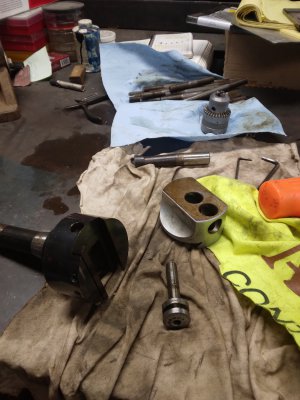Another few days of catch up tool projects. Now that my foot (plantar fasciitis) is feeling better after 3 months of pain, it's nice to be comfortable in the shop again.
Today there were some air guns (blowers) that needed fixing. I really like these guns but they have a hose fitting that doesn't stay put or leaks. Bought a package of 3 and had fixed one by brazing a regular male quick connect fitting to it. The others were hanging there just waiting to also be fixed. I had wanted to do some TIG welding anyway just to keep from forgetting everything so decided to TIG braze them with silicon bronze. Had forgotten how much heat that takes to flow nicely.

Been wanting to figure out a way to hold very short pieces ( both round and rectangle stock) for cutting with the band saw. As I was looking around and engineering in my head, I came across 2 very large V-blocks that have never been used. They came from a large machine shop that I liquidated for a friends father. They are bigger than what would probably ever be used on the machinery in my shop. Probably weigh over 5 pounds each. Had all the clamps and accessories with them. Taking one over to the band saw it was found that they were long enough to hold in the vise and still be able to use the clamp to secure a round piece up to two inches in diameter and just under two inches long.


I usually use step blocks to secure short flat bar stock in the band saw but the last time I couldn't find a pair that were small enough. Those small ones were also located near the big V-blocks.

Day 2
I had quite some time ago made a brake for the shop press. It gets used pretty often but there was only one top die for it and it has been used to bend some heavy metal (1/4”) and had gotten beat up in the middle of the span since the metal is not hardened. Today the bottom, female, die was built up with weld and ground to be straight and with a nice sharp V in it for bending light sheet to a sharp angle. It can take up to 18” long. Then a new 6” top die was fabricated that will stand up to bending the heavy pieces. All the anvil mounts were cleaned up and new thumbscrew bolts made for each to make assembly and disassembly quick and easy.



Day 3
Another build from several years ago had never had the finishing touches added. The slip roll, although used occasionally was awkward to put on a table and precarious to lift since it weighs about 100 pounds. Also many finger pinch points.

Today I put lifting rings on it, added a dedicated mounting shaft that fits in a universal floor stand, and wired up the foot pedal with new wire and battery clamps. It uses a 12-volt wheelchair motor for power.


Day 4
Had 2 tappers that I could not use because they had MT2 arbors. The Tapmatic has some type of drill press taper so a new one was made with a straight shank.

The Procunier was modified by turning and welding a 2-piece straight shank to it. Also made 2 collets (¼ & 5/16”) for the Procunier


All in all, days well spent as these fixes and improvements will make for happier building!
Thanks for looking.
Hope you enjoyed!
Aaron





































